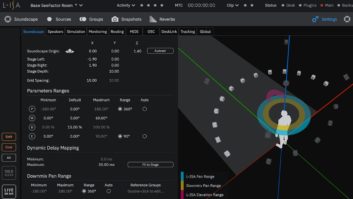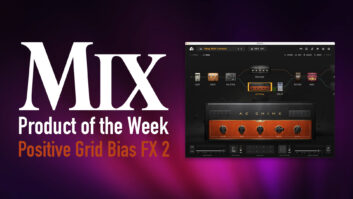
Goodhertz is a California audio software company that makes audio plug-ins and licenses audio algorithms for embedding into Mac OS and iOS platforms. The Faraday Limiter is purpose-designed not only to increase loudness but also to affect tonal color and timbral shape by exerting dynamical control in ways not normally associated with typical limiters or maximizers, hardware or software.
The GUI
In Pro Tools | HDX 12.5.2, Faraday opens in a diminutive square window with Threshold, Ratio, Output Level controls, plus Auto Gain, a large Wet/Dry fader, and two sections called Vibe and Speed. When selected, a list of 12 factory presets slide out in a drawer on the left side, with the main window shrinking to conserve total screen space. As soon as I selected a preset or clicked on the miniaturized main window, the preset list retracted. This design also works well for the advanced controls that slide out on the right side when selected.
Adjusting parameters in Faraday is smooth and responsive, and I liked the unlimited number of undo/redo possible when I would invariably go one tweak too far and want to retrace my steps! I also liked the small Gain Reduction Histogram that graphically shows the last 3 seconds of the limiter’s action—the shapes of the attack and release times and the relative amount of gain reduction. There is also a resettable digital readout of max gain reduction that has occurred since its last reset.
Threshold and Ratio
The Threshold control has an input level peak level meter embedded in its fader. To the left of the Threshold fader is a helpful floating arrow pointer that shows the threshold setting where compression will begin based on the peak signal present at the detector. Whenever the pointer is visible, no gain reduction is occurring at that particular moment. Compression ratio is not continuously variable, and the default is 20:1; there are also fixed 2:1, 4:1 and 8:1 choices.
Vibe
The Vibe section has two faders called Color and Warmth, and they are not EQs. The Color fader controls the amount of transformer saturation for both the input and output modeled transformers. As expected, the total amount of Color is largely dependent on level coming into Faraday and how much compression is desired.
I “crushed” a perfectly recorded bass guitar with the Threshold set to -36 dB (max) and ratio at 2:1—the Gain Reduction Histogram went flat line in full compression at all times. Varying the Color fader from 0 percent (min) or no transformer saturation to 200 percent (max) provided a tremendous palette of transformer distortion colors—super clean and fat sounding at 0 percent and, when set to 200 percent, an unclear and thin, distorted mess with little low-frequency energy.
The Warmth control “tilts” the attack and release timing of Faraday based on the intrinsic spectral balance of the source. With Warmth set to -100 percent, the release timing is much faster for only the high frequencies producing a brighter sound. Warmth at +100 percent weighs on the low frequencies more with a longer release time causing a sluggish and darker nature, akin to severe analog tape compression.
The effect of the Warmth control is source dependent. For my smashed bass guitar test mentioned previously, it was subtle; when I set the Warmth control to +100 percent, it did bring out the sound of the pick the bass player used. Warmth at -100 percent produced a more homogenized, smooth sound.
Speed
Speed has both Attack and Release time faders. Both of these time constants are always adaptive, hence the GUI indicates no specific times in milliseconds or seconds. Multipliers from 0.1x to 8x are used, with 1x as the default. The fastest attack and release times start at the bottom of the faders at 0.1x. Gentle compression can be slow and smooth with release times of more than 150 milliseconds. I found it easy to get all the aggressive limiter action I wanted with fast attack and release times below 1x.
There is an Output Gain fader with a built-in meter to show peak levels for both the input and output level simultaneously. Another floating triangle indicator is used here to indicate where the Output (Makeup) gain would be needed to match roughly the input level for purposes of A/B comparison.
Automatic gain compensation is based on the threshold, ratio settings and where you set Auto Gain itself. I liked that the Auto Gain setting does not change when toggling through different presets.
Presets, Advanced Controls
I always look for a plug-in’s factory presets when first evaluating them, and was pleasantly surprised to find a set of useful setups appropriately named. Factory presets are portable and listed in the online manual as clickable URLs.
When you click on the “Ghz” logo in the GUI, whatever parameters you have running on that instance will show up on a new Web page in your browser. You can copy and send the URL to other users, and you can copy/paste (right click) back and forth between the GUI to the company’s Website.
Faraday Version 2.1 will allow user-created presets to be added to the current list of 12 factory presets in the plug-in manager. Alternatively, you may also use your DAW’s preset manager and copy, rename, modify and save.
The Advanced Controls section slides out to reveal switches for Sidechain source (Internal or External), Sidechain listen, a 20 Hz to 250 Hz -12dB/octave (2nd order) variable sidechain highpass filter, and Sidechain Trim that adjusts the signal level at the detector signal pre-threshold setting and post the Sidechain HPF.
A stereo instance of Faraday adds a Link Amount fader to adjust the strength of the stereo linkage between channels. You can use conventional stereo linking or in M/S stereo mode, the Link Side Gain fader becomes active. It alters the gain of Side signal in the detector only.
I found adjusting Link Side Gain to somewhat control the stereo width for true stereo sources as well as contrived stereo presentations—i.e., four or five guitars panned across a stereo aux fader. The outer hard-panned L/R tracks could be compressed more in a recorded, mixed stereo pair.
Applications
On a pounding 75 BPM stereo drum loop that had a loud snare, I tried and modified the preset called Big Kick. The bass drum came forward, yet the rest of the kit remained clear and not as obviously squashed. Using the Wet/Dry fader allowed setting the snare drum level relative to the increased ambience while adjusting the Link Side Gain and Sidechain Trim faders set stereo size.
Faraday is an obvious choice for stereo music mixes for making them louder. It is very colorful and maybe not to everyone’s taste in this application, but I was able to greatly affect both stereo imaging and tonality of a finished mix. I liked using Faraday for stereo aux buses, stereo instruments and occasionally for reverb returns.
I tried Faraday across a sampled stereo piano track, and it produced the classic rock ’n’ roll piano sound I remember from my youth. It sounded compressed but not too dulled and filled out the song’s track nicely with good sustain, harmonic density and a bright character.
I used Faraday as a more conventional single-channel vocal compressor for a female singer. I am finding that Faraday works better at more extreme settings than other plug-ins where I’m going for a compressor effect. Yes, I can hear the artifacts, but they sounded good and vibey in this case. I always used HQ Mode.
The Faraday Limiter is super-useful and all about vibe! I don’t think of it as a limiter but more as tone-sculpting tool. Highly recommended!
Barry Rudolph is an L.A.-based recording engineer and educator.
Product Summary
COMPANY: Goodhertz Inc.
PRODUCT: Faraday Limiter Version 2
WEBSITE:goodhertz.co/faraday-lim
PRICE: $95 MSRP
PROS: Best vibe-filled plug-in limiter yet.
CONS: Plain-Jane look of the GUI.







